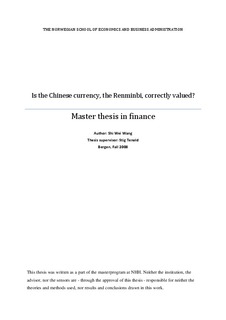| dc.description.abstract | China has since the beginning of this decade been accused of artificially keeping its currency the RMB low in order to increase its exports. This have triggered protectionist acts from the US and demands of a RMB revaluation. This thesis will test this accusation by answering the following question. “Is the Chinese currency, the Renminbi, correctly valued?” International trade motivated by the concept of comparative advantage have many benefits and drawbacks. One drawback is the deterioration of domestic industries competing with international export industries. In order to prevent this protectionist acts are used. One way of pressuring another country to reduce its exports is through currency appreciation. In order to answer the asked question a thorough presentation of the international foreign exchange market will be presented. In the same section, the determination of exchange rates in the long and short run will be examined. Closing this section a Behavioural equilibrium exchange rate (BEER) model, that is used by academics and practitioners of currency forecasting, will be presented. China has been highly advanced throughout its rich and vast history. By recognising this we can understand more of why economic growth is so important for China today. In the history section of this thesis Chinas history will be presented with the focus on the economic development and various growth factors. This will lead to the addressing to the topic at hand, namely the alleged undervalued RMB that has provoked protectionist acts. In this section an interesting notion on the Plaza Accord will also be presented in detail. This will show that China is not the only country that has been pressured by the US to alter its currency in order to improve a deteriorating US economic. The analysis of this thesis will be largely based on the theory presented in the first section. The methods of currency determination will be presented in order of sophistication. Starting with the basic Big Mac Index and ending with a multilateral BEER model. In closing this section a analysis will be preformed to see who will gain and lose in a due to protectionism between China and the US. | en |
